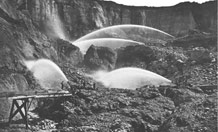
Mercury from gold mining in California’s Sierra Nevada mountains 160 years ago is contaminating food webs in San Francisco Bay.
After the gold rush
New research suggests that 19th C. gold mining in California remains a major contamination risk.
Toxic sediment, the legacy of industrial-scale California gold mining 160 years ago could be an important source of lowland food chain contamination according to new research from the University of Exeter and collaborators published in the journal Proceedings of the National Academy of Sciences (PNAS).
The study suggests mercury-contaminated sediment, resulting from 19th Century hydraulic gold mining in California’s Sierra Nevada, is delivered to lowland areas every time there is a major flood.
This contaminated sediment often infills confined river valleys, which undergo subsequent incision once the supply of mining sediment is stopped. Such fan-shaped deposits of contaminated sediment, known as fans, are likely to increase in number and scale across the globe as demand increases for mined metals and rare earth elements.
Until now the processes by which mercury is delivered to lowlands and the patterns of its distribution have been poorly understood. However, the research makes clear the links between upland legacy sediment from mining and lowland contamination, which are crucial to issues of river management relevant to licensing for mining or dams in this and other basins around the world.
Rolf Aalto, an Associate Professor in Physical Geography at the University of Exeter, said: “Mercury is mainly associated with fine sediment, so contamination sources and trajectories were assumed to be contained behind dams located between the original hydraulic mining sites in the Sierra Nevada and the floodplains and waterways of the Sacramento Valley.
“Our research has now documented that vast quantities of contaminated fine sediment remain 'in play' from local sources within the valley, emphasising the importance of understanding these dynamic and continually evolving lowland rivers.”
Dr Michael Singer of the University of St Andrews said: “We were quite surprised about the immense activity of fan erosion during these large floods. Nothing happens for a decade and then the whole river system is reworked within a few days or weeks. And this wholesale redistribution of mercury-laden sediment to lowlands is likely to occur more frequently given current predictions of regional climate change.”
The team studied fan evolution in this system, using historical data as well as NASA flood imagery. They showed how massive mining sediment slugs which choked Sierra rivers and formed ‘anthropogenic fans’ grading to the margins of the Central Valley are being eroded as terraces collapse during flood events occurring once a decade, moving huge quantities of contaminated sediment into sensitive lowland ecosystems.
The research will enable better anticipation, prediction, and management of contamination risk to the food chain.
Dr Singer, a Lecturer at the School of Geography and Geosciences at St Andrews, continued: “The big concern is that these contaminated sediments are subjected to frequent inundation in the lowlands, which will increase the rates at which the mercury is converted to its bioavailable form and taken up into food webs.”
The research also involved the University of California - Santa Barbara, the University of South Carolina, Sonoma State University and the Computational Modeling Center, Air Products and Chemicals in the US.
This work was supported by the NSF, The Carnegie Trust for Scottish Universities and The Royal Society of Edinburgh to MBS.
Date: 28 October 2013
